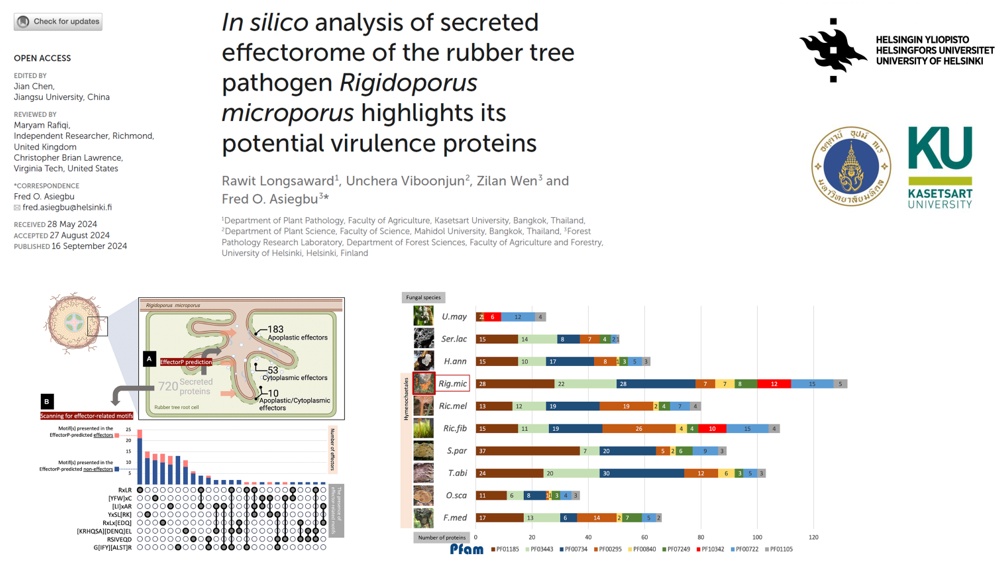Frontiers in Microbiology 15 (2024): 1439454
https://doi.org/10.3389/fmicb.2024.1439454
Rigidoporus microporus, the fungus that causes white root rot disease in rubber trees, is a major threat to natural rubber production worldwide. Understanding how this fungus causes disease is important for developing better ways to manage it. The fungus releases effector proteins, which help it weaken the rubber tree’s defenses and cause infection. In this study, we used computer analyses to identify 357 possible effector proteins from the R. microporus genome. This information were combined with previous RNA-seq data to study how these proteins respond to rubber tree latex. Many of the identified effectors belong to protein families linked to the fungus’s ability to cause disease, especially hydrophobin and glycoside hydrolase (GH) proteins. The role of these secreted effectors in helping the fungus infect rubber trees was discussed, particularly how they react to rubber tree latex. The structures of some unknown, highly active effectors were predicted and found to resemble proteins like aminopeptidase, ubiquitin ligase, spherulin, and thaumatin. This study helps explain how R. microporus infects rubber trees and suggests new targets for controlling white root rot disease in rubber plantations.
Rigidoporus microporus ซึ่งเป็นเชื้อราก่อโรครากขาวในต้นยางพารา ถือเป็นภัยคุกคามสำคัญต่อการผลิตยางธรรมชาติทั่วโลก การทำความเข้าใจกลไกการก่อโรคของเชื้อราชนิดนี้จึงเป็นสิ่งสำคัญสำหรับการพัฒนากลยุทธ์การจัดการโรคที่มีประสิทธิภาพ เชื้อรานี้ผลิตโปรตีนที่เรียกว่า “เอฟเฟกเตอร์” ซึ่งมีบทบาทสำคัญในการปรับเปลี่ยนการตอบสนองภูมิคุ้มกันของพืชและทำให้เป็นโรคได้ง่ายขึ้น ในการศึกษานี้ มีการใช้วิธีชีวสารสนเทศเพื่อระบุโปรตีนเอฟเฟกเตอร์ที่เป็นไปได้จำนวน 357 ชนิดจากจีโนมของ R. microporus พร้อมกับข้อมูล RNA-seq ของเชื้อราที่แสดงการตอบสนองหลังจากสัมผัสกับน้ำยางพารา การวิเคราะห์หน้าที่ของโปรตีนเอฟเฟกเตอร์พบว่ามีโปรตีนจำนวนมากที่เกี่ยวข้องกับความสามารถในการก่อโรคของเชื้อรา โดยเฉพาะโปรตีนไฮโดรโฟบิน (hydrophobin) และโปรตีนไกลโคไซด์ไฮโดรเลส (glycoside hydrolase) นอกจากนี้ยังมีการทำนายโครงสร้างโปรตีนของเอฟเฟกเตอร์บางชนิดที่แสดงออกสูง พบว่ามีความคล้ายคลึงกับโปรตีนอามิโนเปปติเดส (aminopeptidase) ยูบิควิตินไลเกส (ubiquitin ligase) สเฟอรูลิน (spherulin) และโธมาติน (thaumatin) งานวิจัยนี้ช่วยเพิ่มความเข้าใจในกลไกการก่อโรคของ R. microporus และนำเสนอแนวทางใหม่ในการพัฒนาวิธีควบคุมโรครากขาวในสวนยางพารา

